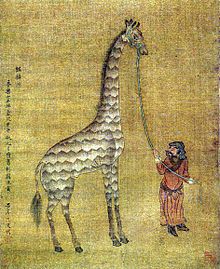In A Pledge of Better Times, when Lady Diana visits the Tower of London--on a historic and tragic occasion in the summer of 1685--she's eager to see the lions in the Royal Menagerie. For centuries, foreign rulers had presented exotic animals to the English monarch, but the giraffe was not one of them. During the Stuart age it was a known species, but it hadn't yet arrived in Britain. Diana would have imagined one that looked something like this:
The earliest artists who rendered the giraffe had not actually seen one and were working from verbal descriptions only--which is why the ossicones initially appear as sharp horns. In times past, the animal was called the Camelopard or Camelopardel or Cameleopard from an ancient belief that it was a hybrid of the two! Of course, this is scientifically impossible but the description fits. In common with a camel, it has a long neck and long legs and hooves. Like a leopard, it has spotted markings. It is a ruminant (cud-chewing vegetarian, subsisting on plants and leaves) and an ungulate (hoofed mammal).
 |
| Giraffe in early Asian art |
 |
| Giraffe illustration in a Greek text |
 |
| European version of a giraffe |
In 1827, in the reign of George IV, the first living giraffe reached England.
 |
| His Majesty's Giraffe, a gift from Egypt |
The satirical printmakers took notice. Here, in an imaginary scene, the overweight King and his mistress are riding the giraffe.
 |
| His Majesty on the giraffe |
Most of us are well aware of the tragic depredations to the wild elephant and rhino populations, but the plight of the giraffe is less well known. I'm thankful that the expectant couple, April and Oliver, and the intense publicity centred on their home at Animal Adventure Park have expanded education and information about the plight of their species. Knowledgeable fans can tell you the pair are reticulated giraffes. This type is sometimes referred to as the Somali giraffe and lives in that country as well as parts of Kenya and Ethiopia. The current status of this subspecies is Vulnerable, placing it in the Threatened category with a native population reduced to 9000 or less.
During my husband's travels in West Africa, he was fortunate to see a herd of Kordofan giraffes (Giraffa camelopardalis antiquorum). I stayed in England to carry out novel research and concentrate on family matters, and during his weeks on the subcontinent maintaining telephone contact was challenging to say the least. But I clearly recall how thrilled I was when he described that experience, and on seeing his photographs of wild giraffes. According to the Giraffe Conservation Foundation, this is one of the most threatened subspecies, with only 2000 remaining in the wild.
All my life, from my very youngest years, I've loved the stately, graceful giraffe. In grad school, my first film project featured giraffes, and I've been privileged to view them in several of the world's most renowned zoos. Over the years, the care, nutrition, and habitats of these creatures have become ever more sophisticated and scientifically based. Numbers and longevity within wild native herds have drastically declined, due to poaching, predation (primarily by big cats and hyenas), starvation from drought, and other factors. A giraffe is lucky if it lives a dozen years. For this reason, captive breeding programs like the one involving April and Oliver become increasingly important--and necessary. Though we might feel concern about so many wild species living in captivity and confinement, their survival now requires it. A giraffe raised at a zoo or wildlife park can reach twenty-five years, or more. There are various organization devoted to preserving giraffes, and they provide all kinds of online information and resources.
If you wish to contribute to the care of April, her calf-daddy Oliver, and their offspring, visit the official April the Giraffe GoFundMe Page.
I'm somewhat familiar with the area where the animal park is located. Although I've not yet visited it, my Giraffe Cam viewing leads me to contemplate a trip to meet the parents, their new arrival, and the many other exotic and domestic animals and wildlife in residence there.
 |
| You can follow @ApriltheGiraffe on Twitter |

